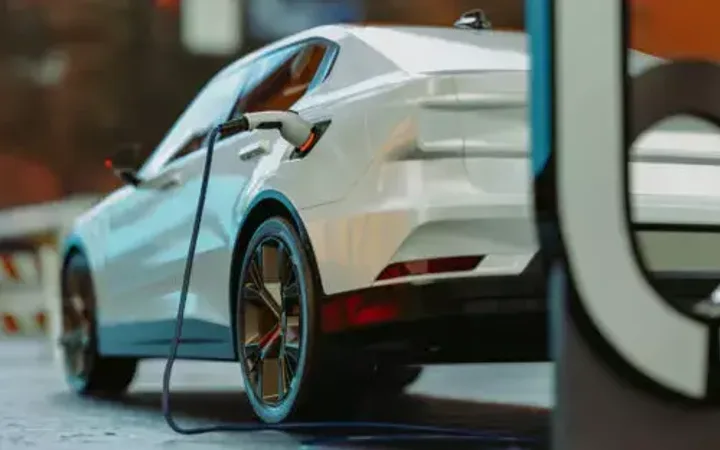An advanced temperature control technique developed for space missions could revolutionise electric vehicle charging times — one of the most critical barriers to widespread adoption. Here, our expert Niall Hendry explains how it works and explores how viable this technology could be.
The EV charge time problem #
Motorway services and the electric vehicle (EV) charging network are two much maligned pieces of the UK’s transport infrastructure, often with justification. Over the recent festive period, both came together in a perfect storm that left many EV owners bereft of holiday cheer. You may have seen photos on social media showing long queues of EVs whose owners set off full of comfort and joy only to find themselves stuck at busy motorway service stations at the mercy of the UK’s under-resourced and often unreliable charging network. Many owners spoke of having to wait several hours for a charging point to become available, including Tesla owners who — up until now — have at least enjoyed the exclusive use of the fastest and largest groups of chargers at those locations.
There are a number of reasons why the EV charging network in the UK is seen as a barrier to EV uptake, but a key one to highlight is arguably beyond the control of charging companies: charge time. If you are used to enjoying a home- or office-based charging point, then the time that it takes to charge your vehicle is not particularly important. However, when you are looking to travel with your EV away from your home or office, you will need to wait around 30 minutes for a decent top-up charge. This is undoubtedly once of the downsides to EV ownership, as it only takes a few minutes to fill a traditional vehicle with fuel. Add in the fact that there are usually no more than a dozen chargers at some key locations and the time you spend waiting for your top-up charge can go well beyond the half-hour mark, as many found during the holidays.
Improving charge times — it might be rocket science… #
While this is far from ideal, a new NASA-sponsored project could provide an unlikely source of hope. To ease consumer concerns, charging sites need to become more akin to garage forecourts, with EVs driving in, taking a five-minute charge and then heading on their way. As outlined in a ‘technology highlights’ post on the NASA website, an advanced temperature control technique developed for space missions could make ultra-fast charging a reality.
Future NASA space missions need to keep various complex systems — including nuclear fission power systems, vapour compression heat pumps and life support systems — at pre-determined temperatures for them to operate correctly. These require advanced heat transfer capabilities to execute the thermal control required.
A team sponsored by NASA’s Biological and Physical Sciences Division is now developing a new technology that it hopes will significantly improve heat transfer performance and allow the aforementioned systems to maintain safe temperatures in space, while at the same time reducing the size and weight of the associated hardware. This same technology could also be applied to electric vehicles back here on Earth.
Ultra-fast charging — how would it work? #
The project team, led by Professor Issam Mudawar of Purdue University, has developed the Flow Boiling and Condensation Experiment (FBCE). This allows two-phase fluid flow and heat transfer experiments to be conducted in the long-duration microgravity environment on the International Space Station (ISS).
As the NASA post explains:
“The FCBE’s Flow Boiling Module includes heat-generating devices mounted along the walls of a flow channel into which coolant is supplied in liquid state. As these devices heat up, the temperature of the liquid in the channel increases, and eventually the liquid adjacent to the walls starts to boil. The boiling liquid forms small bubbles at the walls that depart from the walls at high frequency, constantly drawing liquid from the inner region of the channel toward the channel walls. This process efficiently transfers heat by taking advantage of both the liquid’s lower temperature and the ensuing change of phase from liquid to vapor. This process is greatly ameliorated when the liquid supplied to the channel is in a subcooled state (i.e., well below the boiling point). This new “subcooled flow boiling” technique results in greatly improved heat transfer effectiveness compared to other approaches and could be used to control the temperatures of future systems in space.”
As with all electrical applications, when charging an EV you are passing an electrical current through a conductor, which generates heat. The higher the current, the greater the heat generated. Reducing the time to top-up the battery of an EV to around five minutes is the consumer ideal and a goal for the industry generally. However, this means reducing charging times by a factor of four or five from what they are currently, which would need current to be supplied at four or five times the existing rates. Inevitably, these increases would generate significantly more heat than the existing systems and therefore would need improved methods to control temperature if they were to meet safety standards.
The “subcooled flow boiling” principles learned from the NASA FBCE experiments could be the solution. When the project team pumped dielectric liquid coolant through a charging cable, it captured the heat generated by the cable’s current-carrying conductor. The team found that the subcooled flow boiling allowed them to deliver 4.6 times the current of the fastest available electric vehicle chargers on the market today by removing up to 24.22 kilowatts of heat.
This means that in the future, quick ‘garage forecourt’ charging could be possible for EVs, rendering holiday queues for chargers a thing of the past. All thanks to a technology that was originally built for and tested in outer space — rather than Charnock Richard services on the M6.
If you’re innovating in electric and autonomous vehicle technologies, our multidisciplinary automotive team can provide the IP advice you need to move forward securely. Get in touch with me at [email protected] to arrange a free initial chat.





















